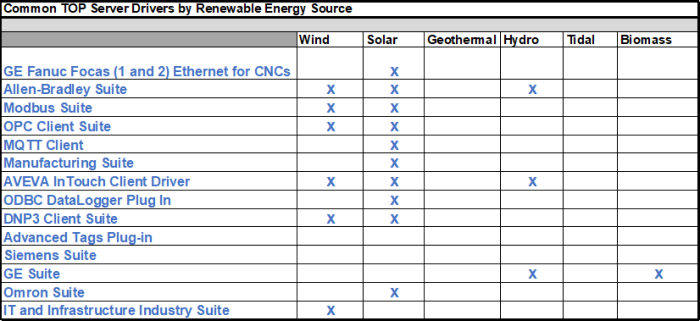Firstly, Happy Belated Earth Day to all that celebrated on Saturday!
Currently, renewable energy generates around 20% of all electricity in the US. This percentage increases daily - you may have seen more solar panels popping up around your neighborhood! This allows us greater potential to modernize the grid through renewable energy within our communities. As the potential for more energy generation increases, the need for more jobs within this sector increases as well. In fact, with the Inflation Reduction Act of 2022 (IRA), the more than $50 billion in clean manufacturing investments in the law will create an estimated 900,000 jobs over the next decade. These strong investments will initiate a manufacturing revitalization and help to move clean manufacturing to center stage within the US.
In this fourth and final installment of our Environmental Sustainability blog series, we are going to take a look at commonly used software solutions that our clients in the Renewable Energy sector have implemented to assist with sustainable energy production.
Because renewable energy is growing and will keep doing so as a means to lower our carbon footprint while providing affordable and clean energy, we wanted to take a look at the most common automation software solutions our clients are using within the Renewable Energy sector. Possibly you might be working in this field yourself or know someone who is, or just be wondering what some other people in the industry are using, so let’s take a look!
NOTE: Please keep in mind that while the solutions in this article are what we’ve observed our customers implementing, this list is by no means an exhaustive list. Please bear in mind that Software Toolbox has lots of options beyond what is covered in this article for the widest range of PLCs, devices and protocol that may be in use on your specific projects.
TOP Server® in the Renewable Energy Sector
When choosing a controller design for a renewable energy project, the main thing to consider is the processing capability - can your design do what you need it to do? This will, in turn, determine how responsive the controllers you select can be with respect to upstream communications for the data demands of your client applications such as HMIs, SCADAs, historians and more. Delayed response times can occur when your controller hasn't been sized according to the processing and communication demands required of it, thus becoming overloaded and degrading both reliability and communications throughput which we all want to avoid this!
Such bottlenecks on data availability must be considered during the design process as solutions. TOP Server is incredibly scalable with respect to how few or how many PLCs, RTUs and other control devices it can connect to, TOP Server can't workaround fundamental network or device limitations. To be clear, there are no artificial licensing limits on the number of tags, devices, or clients for most TOP Server drivers, though some premium drivers and suites such as DNP3 or IEC 60870-5 Suites offer device limited licensing tiers for economical connectivity on smaller projects.

Within the Solar Power industry, commonly adopted PLCs include GE RX3i controllers, Emerson Ovation controllers and Allen-Bradley ControlLogix controllers, including the ABB AC500 designed specifically for solar panels. Modbus and GE controllers are also commonly used on wind farms. And AVEVA InTouch solutions can be seen at hydropower plants, and both solar and wind farms as well. The TOP Server offers drivers for all of these specific protocols and more.
The MQTT protocol (Message Queue Telemetry Transport) is another commonly used standard by several of our customers within the solar industry, as well, and the TOP Server has an MQTT Client driver for it. MQTT is one of a few Industrial Internet of Things (IIoT) protocols useful for compiling data from a wide range of device types into a centralized cloud broker (on-premise or hosted) and can help address connectivity challenges within the energy industry (as well as virtually all other industries). The TOP Server MQTT Client provides read access to common MQTT broker solutions allowing you to incorporate data from any devices that broker has available with your control system, making it available to your HMI, SCADA, historian, ERP system and more.
If you find that you are using multiple TOP Server drivers, you might find it helpful to check out the TOP Server Vertical Industry Suites. These packages combine the most commonly used drivers for specific industries. As you can see from the chart above, the TOP Server IT and Infrastructure Suite is currently used by some of our clients that work with turbines in wind farms.
For more information on specific TOP Server drivers, visit our website and see the full list of drivers and plug-ins available.
LGH File Inspector for AVEVA InTouch in the Renewable Energy Sector
The LGH File Inspector is used with several of our solar and biomass industry customers.

As was discussed in our second blog post in our Environmental Sustainability blog series, predictive maintenance allows for us to proactively address issues, using less resources in the process. Utilizing the LGH File Inspector within your project enables easy, scalable, fast access to local daily historical data files. So when an issue arises, you’re able to see that it’s coming and take the necessary measures to prevent it.
For more information on the LGH File Inspector, check out the licensing options here: https://products.softwaretoolbox.com/lgh-file-inspector/ordering.
Cogent DataHub® in the Renewable Energy Sector
Cogent Datahub products are used in multiple capacities within the renewable energy space.

With its versatile, a la carte style of licensing, a variety of technical connectivity challenges can be addressed. This is especially true when it comes to keeping decision makers up-to-date with relevant real-time data. For example, the OPC DataHub Pack, can feed the data to your web browser and keep your data up-to-date, without refreshing your screen and with a small processing load on your web browser, providing actionable information to decisions makers in real-time from any browser (even on their phones).
The DataHub Tunneling and WebView Packs are also utilized by wind farm operators to obtain data from different farms across broad distances where the data can then aggregated at a central office. The data is then securely tunneled from the SCADA system to their central office where the client then used WebView to build web pages so that a summary screen was available to all of the farms, providing a comprehensive view of the overall operation across sites.
Read more about Cogent DataHub use cases here: https://cogentdatahub.com/industries/energy/
OPC Data Logger in the Renewable Energy Sector
The OPC Data Logger offers a cost-effective solution for retrieving event-driven data logging to text files and databases from OPC UA and DA sources. It can store data in Microsoft SQL, Azure SQL, MySQL and others or text/CSV file formats for easy use.

Read here about a use case where a client used the OPC Data Logger to log process data to SQL. This use case involved collecting data to optimize the Combined Heat & Power Partnership (CHP) at a German R&D firm. For those of you unfamiliar with CHP, it’s a process where technology systems are designed to capture wasted thermal energy that has been produced when generating electricity, thus increasing the efficiency of the overall system.
OPC Router in the Renewable Energy Sector
The OPC Router also utilizes an a la carte style selection of the exact features you need for a project. We mainly see customers within the solar energy space of the renewable energy sector using the OPC Router currently, but the available functionality of OPC Router lends itself to any renewable energy venture!

OPC Router provides drag-and-drop workflow style configuration ability, as well as templates and mass instance creation options for scalability and ease-of-use. The OPC Router offers multiple options for streaming data to the cloud, as well as combining information from SAP.
For more information on the OPC Router, check out the product focus website at: https://products.softwaretoolbox.com/opc-router/visual-workflow-opc-iiot-sap-database-integration-software
Please feel free to contact our support team with any questions and remember to subscribe to our blog for more posts on sustainability, best practices and other industrial automation topics and how-tos.




